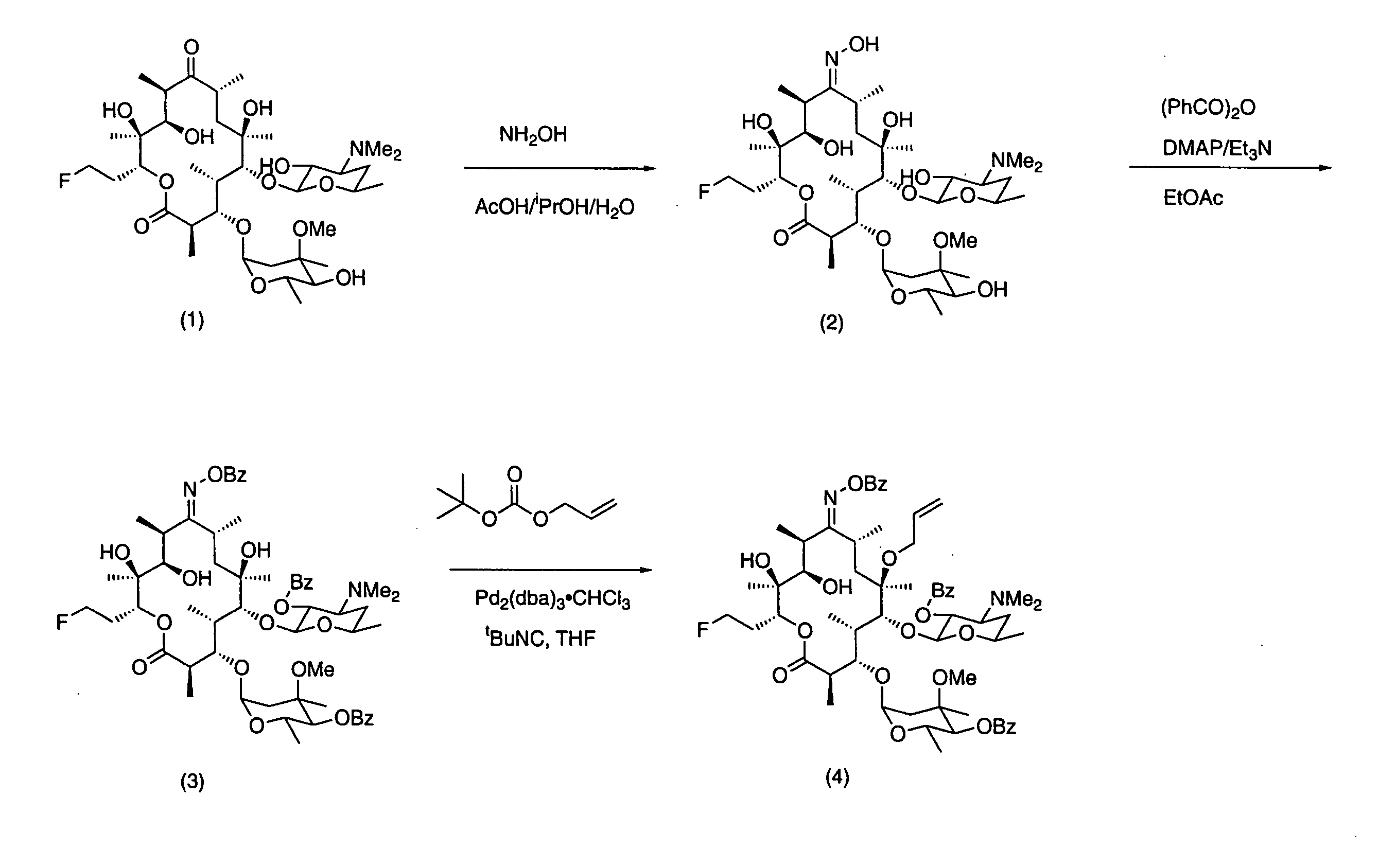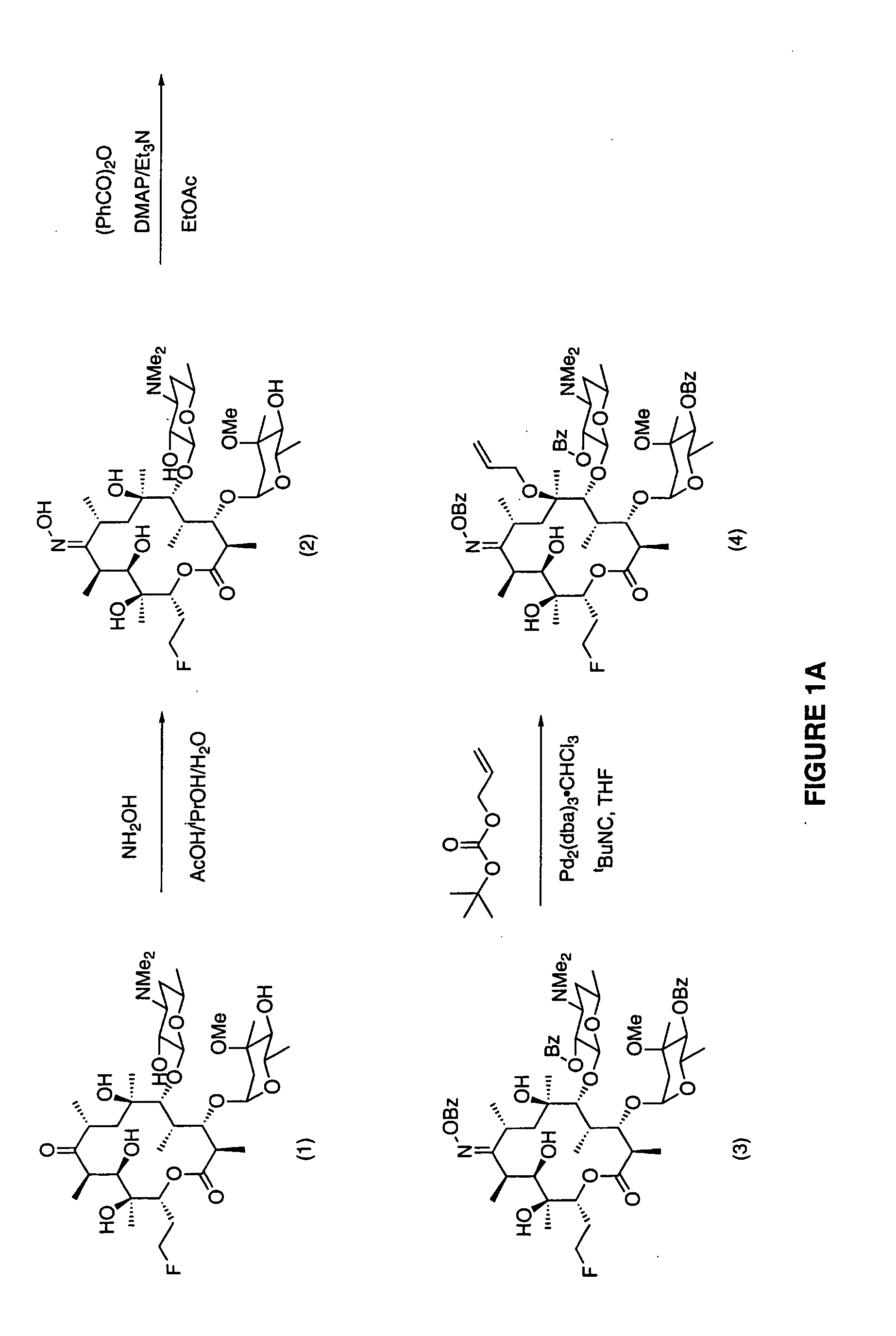7-Quinolyl ketolide antibacterial agents
a technology of ketolide and quinolyl ketone, which is applied in the field of antibacterial compounds, can solve the problems of significant safety risks associated with the use of antibacterials, potent danger to public health, and prolong the qt interval in the electrocardiogram, so as to improve safety and efficacy.
- Summary
- Abstract
- Description
- Claims
- Application Information
AI Technical Summary
Benefits of technology
Problems solved by technology
Method used
Image
Examples
example 1
3-Fluoropropanal
[0079] Trichloroisocyanuric acid (17.0 g, 73 mmol) was added in ˜1 g portions over 1 hour to a vigorously stirred mixture of 3-fluoropropanol (15.6 g, 200 mmol), NaHCO3 (16.8 g, 200 mmol), and TEMPO (0.35 g, 2.2 mmol) in CH2Cl2 (300 mL) and water (10 mL). The temperature was kept at 20˜25° C. using a water bath. After addition was complete, the mixture was stirred until the orange color fades to a pale yellow (approximately 30 minutes). The resulting solution was decanted from the gummy white residue, filtered through a pad of silica gel (5 g), and dried over MgSO4 (10 g) for 30 minutes to provide a solution of 3-fluoropropanal in CH2Cl2. The concentration was determined by 1H-NMR as described for 3-chloropropanal above using the formula:
[3-fluoropropanal]=(integral of δ 9.83) / (integral of δ 5.28)*31.2
This procedure provided an approximately 0.5 M solution of 3-fluoropropanal in CH2Cl2, which was stable for several weeks when stored at −20° C.
example 2
N-[(2R*,3S*)-5-fluoro-3-hydroxy-2-methylpentanoyl]-2-benzoxazolone
[0080] Titanium tetrachloride (15.8 mL, 144 mmol) was added over 5 minutes to a vigorously stirred solution of N-propionyl-2-benzoxazolone (25.0 g, 131 mmol) in anhydrous CH2Cl2 (250 mL) cooled on ice and maintained under inert atmosphere. After 10 minutes, the yellow slurry was treated with N-methylmorpholine (15.8 mL, 144 mmol) over 5 minutes, and stirring was continued for an additional 45 minutes. A 0.48 M solution of 3-fluoropropanal (310 mL, 150 mmol) was added to the dark red solution over 30 minutes, such that the internal temperature remained below 10° C. After addition was complete, the mixture was stirred for an additional 30 minutes on ice, then at warm to ambient temperature an additional 1 hour. The reaction was treated with 250 mL of 2 N HCl with vigorous mixing, and the phases were separated, discarding the aqueous phase. The organic phase was filtered through a pad of silica gel (10 g), which was sub...
example 3
(±)-(2R*,3S*)-5-fluoro-3-hydroxy-2-methylpentanoyl N-propionylcysteamine thioester
[0081] A 25% (w / v) solution of sodium methoxide in methanol (22 mL) was added to a stirred solution of N,S-dipropionylcysteamine (18.9 g, 0.1 mol) in 100 mL of methanol at ambient temperature maintained under inert atmosphere. After 15 minutes, acetic acid (4.0 mL) was added, followed by solid N-[(2R*,3S*)-5-fluoro-3-hydroxy-2-methylpentanoyl]-2-benzoxazolone (26.7 g, 0.1 mol). The mixture was stirred for 15 minutes after complete dissolution of the solid is noted, then acetic acid (1.7 mL) was added and the mixture was evaporated under vacuum to yield a thick oil. The oil was dissolved in 500 mL of ethyl acetate and washed once with 500 mL of water. The organic phase was washed once with 250 mL of saturated aq. NaCl, then dried over MgSO4, filtered, and evaporated on the rotary evaporator to yield a thick yellow oil. The residue was dissolved in a minimal volume of dichloromethane and applied to a 10...
PUM
| Property | Measurement | Unit |
|---|---|---|
| Fraction | aaaaa | aaaaa |
| Fraction | aaaaa | aaaaa |
| Temperature | aaaaa | aaaaa |
Abstract
Description
Claims
Application Information
 Login to View More
Login to View More - R&D
- Intellectual Property
- Life Sciences
- Materials
- Tech Scout
- Unparalleled Data Quality
- Higher Quality Content
- 60% Fewer Hallucinations
Browse by: Latest US Patents, China's latest patents, Technical Efficacy Thesaurus, Application Domain, Technology Topic, Popular Technical Reports.
© 2025 PatSnap. All rights reserved.Legal|Privacy policy|Modern Slavery Act Transparency Statement|Sitemap|About US| Contact US: help@patsnap.com



